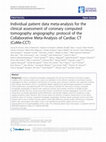Papers by Elke Zimmermann
Background: Claustrophobia is a common problem precluding MR imaging. The purpose of the present ... more Background: Claustrophobia is a common problem precluding MR imaging. The purpose of the present study was to assess whether a short-bore or an open magnetic resonance (MR) scanner is superior in alleviating claustrophobia.

PURPOSE Global left ventricular function is usually represented by values related to the maximal ... more PURPOSE Global left ventricular function is usually represented by values related to the maximal and minimal filling of the left ventricle but offer no information about the underlying hemodynamics. But volume-time curves (VTC) obtained by magnetic resonance imaging (MRI) offer a quantitative assessment of left ventricular hemodynamics. As 64-row computed tomography (64-row CT), despite its lower temporal resolution, can also be used to obtain VTCs, we sought to compare 64-row CT with MRI for static functional parameters as well as VTCs. METHOD AND MATERIALS A total of 39 patients underwent both MRI and CT with standardized examination protocols. VTCs were generated for CT and MRI. For this we used a bicubic spline model to emulate 20 time points (5% steps) of the cardiac cycle. Furthermore end-diastolic and end-systolic volume (EDV and ESV), ejection fraction (EF) as well as peak filling rate (PFR) and peak ejection rate (PER) were calculated. Data was analyzed using student’s t-te...

PLOS ONE, 2015
The aim of this study was the systematic image quality evaluation of coronary CT angiography (CTA... more The aim of this study was the systematic image quality evaluation of coronary CT angiography (CTA), reconstructed with the 3 different levels of adaptive iterative dose reduction (AIDR 3D) and compared to filtered back projection (FBP) with quantum denoising software (QDS). Standard-dose CTA raw data of 30 patients with mean radiation dose of 3.2 ± 2.6 mSv were reconstructed using AIDR 3D mild, standard, strong and compared to FBP/QDS. Objective image quality comparison (signal, noise, signal-to-noise ratio (SNR), contrast-to-noise ratio (CNR), contour sharpness) was performed using 21 measurement points per patient, including measurements in each coronary artery from proximal to distal. Objective image quality parameters improved with increasing levels of AIDR 3D. Noise was lowest in AIDR 3D strong (p≤0.001 at 20/21 measurement points; compared with FBP/QDS). Signal and contour sharpness analysis showed no significant difference between the reconstruction algorithms for most measurement points. Best coronary SNR and CNR were achieved with AIDR 3D strong. No loss of SNR or CNR in distal segments was seen with AIDR 3D as compared to FBP. On standard-dose coronary CTA images, AIDR 3D strong showed higher objective image quality than FBP/QDS without reducing contour sharpness. Clinicaltrials.gov NCT00967876.

RöFo : Fortschritte auf dem Gebiete der Röntgenstrahlen und der Nuklearmedizin, 2010
Cardiac computed tomography (CT) is becoming increasingly important in noninvasive imaging. To me... more Cardiac computed tomography (CT) is becoming increasingly important in noninvasive imaging. To meet this demand, there are a growing number of short training courses for cardiac CT. Whether such courses improve the knowledge and skills of participants is not known. The concept of a two-day cardiac CT course consisting of introductory lectures, live patient examinations, and hands-on exercises for interpreting cardiac CT scans on workstations was analyzed using participant evaluations (scales from 1=excellent to 6=very poor). Participants rated their increase in knowledge and completed a validated questionnaire with 20 questions. A total of 102 participants attended the courses. There were significant differences in the number of correctly answered test questions between cardiac CT experts and participants at the beginning of the course (91.5+/-6.3 % vs. 62.4+/-16.1% p<0.001). The number of questions answered correctly by the participants increased significantly after completion o...

BMJ (Online), 2012
To develop prediction models that better estimate the pretest probability of coronary artery dise... more To develop prediction models that better estimate the pretest probability of coronary artery disease in low prevalence populations. Retrospective pooled analysis of individual patient data. 18 hospitals in Europe and the United States. Patients with stable chest pain without evidence for previous coronary artery disease, if they were referred for computed tomography (CT) based coronary angiography or catheter based coronary angiography (indicated as low and high prevalence settings, respectively). Obstructive coronary artery disease (≥ 50% diameter stenosis in at least one vessel found on catheter based coronary angiography). Multiple imputation accounted for missing predictors and outcomes, exploiting strong correlation between the two angiography procedures. Predictive models included a basic model (age, sex, symptoms, and setting), clinical model (basic model factors and diabetes, hypertension, dyslipidaemia, and smoking), and extended model (clinical model factors and use of the CT based coronary calcium score). We assessed discrimination (c statistic), calibration, and continuous net reclassification improvement by cross validation for the four largest low prevalence datasets separately and the smaller remaining low prevalence datasets combined. We included 5677 patients (3283 men, 2394 women), of whom 1634 had obstructive coronary artery disease found on catheter based coronary angiography. All potential predictors were significantly associated with the presence of disease in univariable and multivariable analyses. The clinical model improved the prediction, compared with the basic model (cross validated c statistic improvement from 0.77 to 0.79, net reclassification improvement 35%); the coronary calcium score in the extended model was a major predictor (0.79 to 0.88, 102%). Calibration for low prevalence datasets was satisfactory. Updated prediction models including age, sex, symptoms, and cardiovascular risk factors allow for accurate estimation of the pretest probability of coronary artery disease in low prevalence populations. Addition of coronary calcium scores to the prediction models improves the estimates.

Systematic Reviews, 2013
Background: Coronary computed tomography angiography has become the foremost noninvasive imaging ... more Background: Coronary computed tomography angiography has become the foremost noninvasive imaging modality of the coronary arteries and is used as an alternative to the reference standard, conventional coronary angiography, for direct visualization and detection of coronary artery stenoses in patients with suspected coronary artery disease. Nevertheless, there is considerable debate regarding the optimal target population to maximize clinical performance and patient benefit. The most obvious indication for noninvasive coronary computed tomography angiography in patients with suspected coronary artery disease would be to reliably exclude significant stenosis and, thus, avoid unnecessary invasive conventional coronary angiography. To do this, a test should have, at clinically appropriate pretest likelihoods, minimal false-negative outcomes resulting in a high negative predictive value. However, little is known about the influence of patient characteristics on the clinical predictive values of coronary computed tomography angiography. Previous regular systematic reviews and metaanalyses had to rely on limited summary patient cohort data offered by primary studies. Performing an individual patient data meta-analysis will enable a much more detailed and powerful analysis and thus increase representativeness and generalizability of the results. The individual patient data meta-analysis is registered with the PROSPERO database (CoMe-CCT, CRD42012002780).
Seminars in Ultrasound, CT and MRI, 2008
Noninvasive coronary angiography has become increasingly important for coronary artery assessment... more Noninvasive coronary angiography has become increasingly important for coronary artery assessment in recent years. Its indications include the exclusion of coronary artery disease and follow-up of patients after bypass surgery. The results can be displayed using various postprocessing techniques such as multiplanar reconstruction, maximum intensity projection, and 3D reconstruction. Adequate interpretation of the imaging findings crucially relies on good anatomic knowledge of the heart and coronary arteries, which includes knowledge of the coronary segments and normal anatomic variants.
Seminars in Ultrasound, CT and MRI, 2008
Coronary computed tomography angiography is an emerging imaging technique that has attracted much... more Coronary computed tomography angiography is an emerging imaging technique that has attracted much scientific attention over the past years. Improved scanner technology and dedicated protocols have made noninvasive coronary a reliable diagnostic test in patients with suspected coronary artery disease (CAD). Several technical steps such as the introduction of 64-slice scanners, multisegment reconstruction, and dual-source computed tomography have substantially improved temporal and spatial resolution. With these sophistications, coronary computed tomography angiography enables reliable exclusion of CAD in patients with low to intermediate pretest probability of having CAD or with inconsistent ischemia test results.
RöFo - Fortschritte auf dem Gebiet der Röntgenstrahlen und der bildgebenden Verfahren, 2009
RöFo - Fortschritte auf dem Gebiet der Röntgenstrahlen und der bildgebenden Verfahren, 2011
RöFo - Fortschritte auf dem Gebiet der Röntgenstrahlen und der bildgebenden Verfahren, 2007
RöFo - Fortschritte auf dem Gebiet der Röntgenstrahlen und der bildgebenden Verfahren, 2006

RöFo - Fortschritte auf dem Gebiet der Röntgenstrahlen und der bildgebenden Verfahren, 2014
Assessment of experience gained by local referring physicians with the procedure of coronary comp... more Assessment of experience gained by local referring physicians with the procedure of coronary computed tomographic angiography (CCTA) in the everyday clinical routine. A 25-item questionnaire was sent to 179 physicians, who together had referred a total of 1986 patients for CCTA. They were asked about their experience to date with CCTA, the indications for coronary imaging, and their practice in referring patients for noninvasive CCTA or invasive catheter angiography. 53 questionnaires (30 %) were assessable, corresponding to more than 72 % of the patients referred. Of the referring physicians who responded, 94 % saw a concrete advantage of CCTA in the treatment of patients, whereby 87 % were &amp;amp;#39;satisfied&amp;amp;#39; or &amp;amp;#39;very satisfied&amp;amp;#39; with the reporting. For excluding coronary heart disease (CHD) where there was a low pre-test probability of disease, the physicians considered CCTA to be superior to conventional coronary diagnosis (4.2 on a scale of 1 - 5) and vice versa for acute coronary syndrome (1.6 of 5). The main reasons for unsuitability of CCTA for CT diagnosis were claustrophobia and the absence of a sinus rhythm. The level of exposure to radiation in CCTA was estimated correctly by only 42 % of the referring physicians. 90 % of the physicians reported that their patients evaluated their coronary CT overall as &amp;amp;#39;positive&amp;amp;#39; or &amp;amp;#39;neutral&amp;amp;#39;, while 87 % of the physicians whose patients had undergone both procedures reported that the patients had experienced CCTA as the less disagreeable of the two. CCTA is accepted by the referring physicians as an alternative imaging procedure for the exclusion of CHD and received a predominantly positive assessment from both the referring physicians and the patients.
RöFo - Fortschritte auf dem Gebiet der Röntgenstrahlen und der bildgebenden Verfahren, 2012
RöFo - Fortschritte auf dem Gebiet der Röntgenstrahlen und der bildgebenden Verfahren, 2009
RöFo - Fortschritte auf dem Gebiet der Röntgenstrahlen und der bildgebenden Verfahren, 2009
RöFo - Fortschritte auf dem Gebiet der Röntgenstrahlen und der bildgebenden Verfahren, 2005



Uploads
Papers by Elke Zimmermann